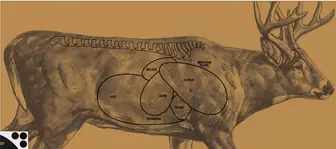|
Where to Shoot Big Game Animals? By Chuck Hawks If you've learned to shoot and hit what you aim at, but are a novice big game hunter, the natural next question is, "where to shoot?" a big game animal. The answer is simple: aim for the heart/lung area in the animal's chest. It is the biggest immediately vital area, at least 8" in diameter in even small deer and pronghorn antelope, and a solid hit there with an adequate bullet will result in a quick kill.  Illustration of deer target courtesy of Brichwood Casey. A shot through the shoulders will usually disrupt the lungs and result in a quick kill. But it ruins a lot of good meat. A shot through the ribs just behind the foreleg wrecks the lungs without ruining hardly any edible meat. Do not attempt brain shots (or head shots of any kind). The brain is very small and animals constantly move and turn their heads, even when they are standing still. Do not attempt neck shots. The neck is large, but the spinal cord inside is small and difficult to sever. Both brain and neck shots are deadly if perfectly executed, as they shut down the central nervous system, but if the bullet is off only an inch or two the animal is very likely to escape and be lost, only to die hours or days later. Never attempt spine shots, especially from behind a fleeing animal. The result will almost certainly be a gut shot animal. Do not shoot at a moving animal. Wait until it stops moving, or find another animal that is not moving. Shots at moving animals often hit too far back, because the hunter fails to lead enough. The result is a gut shot animal that will probably not be recovered--and if it is you may wish that it had not been when you begin to field dress it. Passing up difficult or questionable shots is part of the hunting experience, and the better and more experienced the hunter, the more shots he or she will pass on. Don't shoot if you think you can make the shot (you will probably fluff it), shoot only when you know that you can make the shot. Avoid any shot that will drive the bullet through the guts. That means that you are looking for opportunities where you can shoot from a position somewhere in a broad arc from either side of the animal. The ideal is a perfect broadside shot, but a shot at an animal quartering toward or away from you at angles up to about 45 degrees is acceptable. Some knowledge of the anatomy of the game in question is requisite in order to know where the heart/lung area is. Fortunately, the common game animals in North America of the deer species (deer, caribou, elk, and moose), along with their close relatives in Asia and Europe, are anatomically similar and pretty conventional. So is the pronghorn antelope, although it is not a species of deer. Certain other animals, including the North American mountain goat and musk ox, are anatomically a little different and should be studied individually, although the goal is still to place the bullet into the heart/lung area. The game departments of many states publish drawings showing the location of the vital areas of typical game animals, as do a number of web sites. Type "deer anatomy" into any of the major search engines to find diagrams showing the locations of the heart and lungs. Study these until you can visualize where the heart/lung area is located in the body of the species you intend to hunt. In any of the deer family, viewed broadside, the heart/lung area is directly behind the foreleg. Hold just behind the near side foreleg, about half way up the body, and your bullet should go through the lungs and exit just behind the off side foreleg. (It doesn't matter if the bullet actually exits the animal, but that is the path it should be on.) If the animal is quartering toward you, aim for the center of the chest so that the bullet passes in front of the near foreleg and exits through or immediately behind the off side foreleg (depending on the angle at which the animal is standing). If the animal is quartering away, aim to drive the bullet directly behind the near shoulder so that it passes through the lungs and exits through the off side shoulder. Avoid shots from directly in front of the animal. When the buck's head is up and he is looking right at you, the point of aim would be about where the lower neck joins the body to drive the bullet through the lungs. The problem with this shot is that the bullet is likely to penetrate all the way through the chest and into the guts and make a mess. Learn enough big game anatomy to be able to figure where the heart/lung area is inside of the animal and aim to drive your bullet right through the center of that area. If game animals are rarely encountered near your residence, watch domestic sheep, goats, or cows, visualizing the location of their heart/lung area and how to drive a bullet through it from various angles. Learn to avoid angles where a bullet would puncture the paunch on the way to the lungs. I have had to field dress animals where the bullet perforated the guts on its way to the heart/lung area. Trust me, it is an experience you want to avoid. Good hunting and good shooting! |